A7 Upgrades for 2019 Both Subtle, Substantial
By John Gilbert
There I sat, in my own driveway, checking and cross-checking (well, it was still hockey season!) all the features in the 2019 Audi A7 quattro. My obsession was one thing in particular: the very neat little sunscreen that fits up in front of the long, sloping hatchback rear window.
It worked great for filtering out a lot of the sun and heat, but it was getting on toward evening now, and I wanted to locate the power switch that would drop the screen down flush to improve nighttime visibility out the rear.
There are so many switches and gadgets on the A7, as on most high-end cars these days, that it isn’t always easy to figure out what the heck the little icon is for on the various switches. And sometimes you have to get on the expansive information screen, which is a lot like a computer or iPad, and you find an indication that you can tap an electronic switch and get whatever job you want done.
I knew I would find it, but right then I was a half-hour into perusing all the switchwork and gadgetry in what was becoming a more and more futile exercise.
When an automaker is near perfection, sometimes its evolutionary changes feel a lot like no change at all. That’s a good thing, if the car they’re changing is already at the top of the scale. Audi is that way. The German company builds a full slate of cars nowadays, from compact to sporty to luxury, with a fleet of highly regarded SUVs of all sizes alongside.
But Audi is at its best when it comes to making luxury freeway cruisers, which handle and feel more like sporty sedans but are safe, beautiful and highly efficient. At the top is the A8, and the midsize is the A6, but now they have wedged a sporty, fastback version of the A6 in between and called it the A7.
When you line up all three, it’s very difficult to pick a favorite. The A6 and A8 look different because the A8 is longer, particularly the one that comes to the U.S., which is the A8-L — the elongated version only. Of course, the A7 looks markedly different than both of the others, because of the sleeker, fastback roofline and hatch under it. Personally, I think the A7 is the best looking of the batch, and I did review it as a 2018.
But it has undergone significant changes for 2019, so when a 2019 Audi A7 arrived for me to test drive and evaluate for a week, I studied it carefully to denote all the changes. Different platform underneath it, and a change in 3.0-liter V6 engines, from the supercharged hot one to a turbocharged hot one, still 2.0, and from impressive to…impressive. The interesting thing is that all three cars at the top of Audi’s luxury chain — the A6, A7 and A8-L — all use the same engine with the same power.
And it is so good, smooth and powerful, that nobody is going to complain, especially when you can get right about at 30 miles per gallon on a freeway trip. Of course, the A7 has quattro, Audi’s brilliant all-wheel-drive system, although it is changed considerably from the quattro of years past, which had itself been altered and revised repeatedly. Interesting, quattro put Audi ahead of Mercedes and BMW for those of us who drive in snow part of the year, but now that Mercedes and BMW have realized the inherent advantages of AWD and installed it or made it available on many models, Audi keeps refining its quattro to come at compromise from the opposite direction.
The new quattro has two different differentials, to make the whole system work more efficiently. Audi has conceded that sometimes you want a slight power bias going to the rear, so it has accommodated it. But when you switch to open both clutches, you effectively eliminate the AWD and had only front-wheel drive, which aids in sportiness and performance as well as eliminating a lot of the friction that comes with AWD.
The beauty of the Audi system is that you notice only that the new Audi drives hard, handles well and has great traction in all circumstances, just like the old one did.
As for the engine, the old one had the supercharger, which force-feeds air into the engine, to such more gas and make more, and instant, power. Turbocharging usually takes a bit longer for the exhaust-air-fed flow to do essentially the same thing, which led to traditional “turbo lag” in turbocharged engines, even though fuel efficiency and gas mileage were better than supercharged. Audi has gone back and forth on this, and here is the best comparison.
Last year, the 3.0 dual-overhead cam V6 with the supercharger turned out 333 horsepower and 325 foot-pounds of torque, which peaked between 2,800 and stayed at that peak until 5,300 RPMs. Impressive. Ah, but the little gremlins in their white smocks in Ingolstadt found that by using a twin-scroll turbocharger instead of the supercharger, they could eliminate any lag and could coax the same displacement 3.0 to out 335 horsepower and 369 foot-pounds of torque at a peak that now spans from 1,370 to 4,300 RPMs.
The torque peak is the point where you feel maximum thrust for acceleration, and you needn’t be German to realize that more torque, peaking at lower RPMs — in fact, barely above idle speed — will deliver more power sooner than the alternative. Various tests I’ve read indicate the heavy (4,400-pound) A7 will go 0-60 in about 4.7 seconds, and will hit 105 miles per hour from 0 in 13.3 seconds in a quarter mile. You can’t even get the silky smooth transmission to hit all seven gears in that time.
The base price on the A7 Audi quattro is $68,000, and as tested, loaded with all the options, the sticker was $85,240. If that seems outrageous, you have to look beyond the real leather, wood and aluminum comfort of the interior with its great seats fore and aft, and consider the level of ingredients in that A7.
Handling and performance are aided by the exquisite balance inherent in all Audis, even with their engines hanging out forward of the front axle. It feels perfectly balanced, so it it. The A7 test car came loaded with all the proper safety and connectivity features, plus Audi’s fantastic full-width and adjustable gauge-splitting navigation picture that is a Google map come to life.
There also are settings so you can switch the A7 from automatic to comfort, to dynamic to individual, the latter of which allows you to maybe set the steering and cornering to sportier dynamic levels, and the ride smoothness to comfort. Or whatever.
The car also is notably quieter than it, or any other luxury sedan, used to be. Audi has found the precise spots to add padding, and they doubled the thickness of the windshield gas to improve its acoustic qualities. You also get fantastic headlights and taillights, with their LED splendor, and their sequential operation. The test car also came with what Audi calls “HD Matrix” headlights, with laser high beam control. Audi has taken adaptive headlights one level behind, and these can detect an oncoming car around a curve while aiming the lights to show around the curve. The lights will outline without blinding the oncoming driver.
You’ve got to be kidding!
Everything you could ever want in a car, short of driving for you — and Audi has more autonomous-driving models plying the autobahns of Germany right now! — and it’s all in such a dramatically stunning package. Everything…except, oh yeah, that blasted rear window screen!
Back to my personal drama, sitting in the driver’s seat and having tried every button, switch and icon, and none of them folding down the rear sunscreen.
I was to the point where I simply wanted the blasted thing folded down, so I climbed out, and opened the hatchback, which pops up smoothly and precisely. I decided to reach in and see if I could manually fold down the sunscreen, which has its own little receptacle carved into the panel over the hatch. To my absolute shock, my touch caused the sunscreen to fold down and click into that receptacle!
If you flip the switch, you can readily pop the sunscreen back up and into place. I had to laugh. Audi fooled me again, in a foolproof sort of a way. Maybe in the back rooms at the home factory in Ingolstadt, some engineers are getting a major chuckle out of realizing that normal buyers will search and hunt for a power switch to operate the sunscreen, but when they finally give up and examine the thing first-hand, they will find that simple manual touch still works.


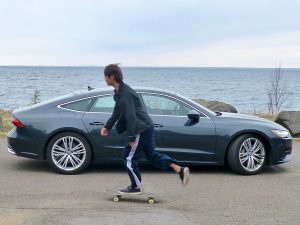
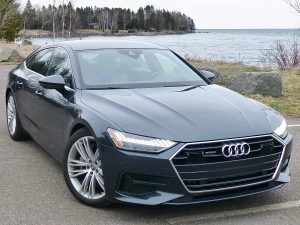
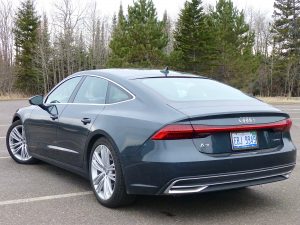
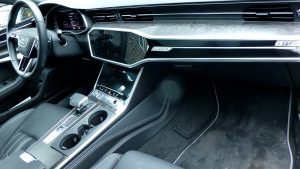
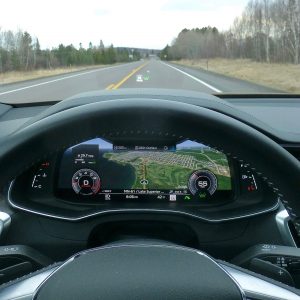
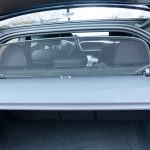
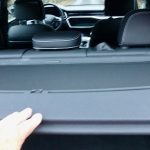
 John Gilbert is a lifetime Minnesotan and career journalist, specializing in cars and sports during and since spending 30 years at the Minneapolis Tribune, now the Star Tribune. More recently, he has continued translating the high-tech world of autos and sharing his passionate insights as a freelance writer/photographer/broadcaster. A member of the prestigious North American Car and Truck of the Year jury since 1993. John can be heard Monday-Friday from 9-11am on 610 KDAL(www.kdal610.com) on the "John Gilbert Show," and writes a column in the Duluth Reader.
John Gilbert is a lifetime Minnesotan and career journalist, specializing in cars and sports during and since spending 30 years at the Minneapolis Tribune, now the Star Tribune. More recently, he has continued translating the high-tech world of autos and sharing his passionate insights as a freelance writer/photographer/broadcaster. A member of the prestigious North American Car and Truck of the Year jury since 1993. John can be heard Monday-Friday from 9-11am on 610 KDAL(www.kdal610.com) on the "John Gilbert Show," and writes a column in the Duluth Reader.